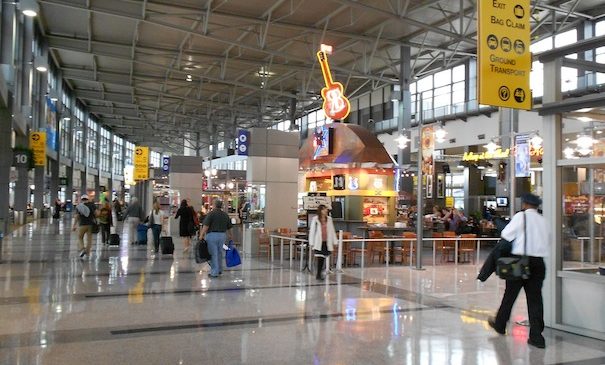Airport Advisory Commission accepts FAA grants for airport expansion
Friday, June 14, 2024 by
Lina Fisher On June 12, the Airport Advisory Commission heard a slew of good news from Austin’s Department of Aviation staff. For one of the fastest-growing airports in the nation, a series of improvements are on their way – chief among them, up to $500 million in grants from the Federal Aviation Administration over the next three years.
First up, a new pipeline from Bastrop to Austin will provide Austin-Bergstrom International Airport with a more efficient and direct source of fuel. The BATX pipeline – currently undergoing permitting discussions with the city and Travis County – will follow State Highway 71 and enter on Presidential Boulevard. Austin’s airport is the largest in the country that still relies on truck deliveries for fuel; this project should improve both the speed and reliability of that process.
Next up, Will Mack, the airport’s financial manager, reported climbing revenues from April 2024 financial results. Operating revenues increased by 18 percent since last year, and year-to-date revenues increased 16 percent. Expenses also increased, exceeding the budget by 5 percent, largely because of improved staffing, increased parking costs and new law enforcement units – however, the budget surplus increased 16 percent from 2023. All in all, a very “favorable performance, especially when it comes to revenues,” Mack said. Those revenues are driven by ever-increasing passenger traffic: Though average daily departures are somewhat down because of American and Spirit airlines cutting flights last fall, that dent will be largely made up by Southwest extending flights for vacation season and by Delta, which has increased its seat capacity 20 percent since 2023 (and become the official airline of the South by Southwest festival).
One particular Austin export is driving airlines to add new flights: “Southwest, American and Delta are adding more than I’ve ever seen for UT football,” reported Jamy Kazanoff, AUS’s deputy chief of air service. “That means airlines are really paying attention – they don’t do that with all big universities.” Copa Airlines, a relatively new addition to AUS, has also extended opportunities for Austinites to foray south of the border to Panama, Colombia, Costa Rica and Brazil.
“When we get one carrier established in Central and South America, it assists with future opportunities for Austin,” Kazanoff said.
Despite the general growth trend, commissioners were wary of the airport’s capacity to handle so many added passengers. However, Kazanoff was quick to point out that flights were on average only about 84 percent full in July 2023, so there was “room for the demand to be absorbed,” she said.
The Austin airport’s capacity will only continue to grow: Staff briefed the commission on several construction projects in the pipeline, part of the airport’s massive $4 billion expansion, dubbed “Journey With AUS.” Many of those will come to City Council this summer for approval on a design firm. In July, a construction firm handling the overhaul of utility infrastructure throughout the entire airport – making sure HVAC, fans, lighting, IT and security are up to date and can connect to new construction – will come before the commission and Council. The midfield taxiway project – two new parallel taxiways that connect the east and west sides of the airfield – will have a maximum guaranteed price document coming before the commission in August. It is 90 percent designed, and construction on it will begin this year and finish in 2027. The choice of the design firm to manage the new midfield concourse – projected to add at least 20 gates and perhaps up to 40, drastically increasing the capacity of the airport – will come to the commission in August.
The other issue at the top of commissioners’ minds is safety. The FAA has awarded AUS ramp control technology, which will improve coordination of planes’ movements once they exit the taxiway and approach the gates. The company that makes the radios needed to install the tool has a 12- to 14-week time frame for manufacturing, meaning it won’t be installed till September.
The commission also approved several items funneling more money to AUS – because of a staffing market study, the airport will receive increased appropriations to the tune of $10 million, reflecting “expenses resulting from the greatly improved vacancy rate that outperformed expectations.” The commission also accepted up to $500 million in grants from the FAA over the next three years, many of which will go toward funding the expansion.
Going forward, commissioners agreed that “speeding the delivery of this extremely important infrastructure update has to be top priority,” Commissioner Patrick Rose said. Chair Wendy Todd added that she wants to balance environmental sustainability and resilience with exponential growth. “There’s money on the table with the infrastructure act to electrify fleets, and for carbon reduction.”
The commission will meet again July 10, requesting updates from AUS on accommodations for passengers with disabilities, parking lot security and a briefing on the FAA Reauthorization Act.
The Austin Monitor’s work is made possible by donations from the community. Though our reporting covers donors from time to time, we are careful to keep business and editorial efforts separate while maintaining transparency. A complete list of donors is available here, and our code of ethics is explained here.
You're a community leader
And we’re honored you look to us for serious, in-depth news. You know a strong community needs local and dedicated watchdog reporting. We’re here for you and that won’t change. Now will you take the powerful next step and support our nonprofit news organization?









